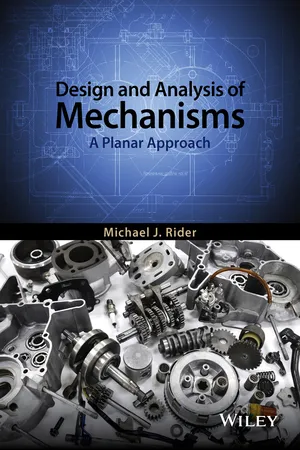
This is a test
- English
- ePUB (mobile friendly)
- Available on iOS & Android
eBook - ePub
Book details
Book preview
Table of contents
Citations
About This Book
A planar or two-dimensional (2D) mechanism is the combination of two or more machine elements that are designed to convey a force or motion across parallel planes. For any mechanicalengineer, young or old, an understanding of planar mechanism design is fundamental. Mechanical components and complex machines, such as engines or robots, are often designed and conceptualised in 2D before being extended into 3D.
Designed to encourage a clear understanding of the nature and design of planar mechanisms, this book favours a frank and straightforward approach to teaching the basics of planar mechanism design and the theory of machines with fully worked examples throughout.
Key Features:
- Provides simple instruction in the design and analysis of planar mechanisms, enabling the student to easily navigate the text and find the desired material
- Covers topics of fundamental importance to mechanicalengineering, from planar mechanism kinematics, 2D linkage analyses and 2D linkage design to the fundamentals of spur gears and cam design
- Shows numerous example solutions using EES (Engineering Equation Solver) and MATLAB software, with appendices dedicated to explaining the use of both computer tools
- Follows end-of-chapter problems with clearly detailed solutions
Frequently asked questions
At the moment all of our mobile-responsive ePub books are available to download via the app. Most of our PDFs are also available to download and we're working on making the final remaining ones downloadable now. Learn more here.
Both plans give you full access to the library and all of Perlego’s features. The only differences are the price and subscription period: With the annual plan you’ll save around 30% compared to 12 months on the monthly plan.
We are an online textbook subscription service, where you can get access to an entire online library for less than the price of a single book per month. With over 1 million books across 1000+ topics, we’ve got you covered! Learn more here.
Look out for the read-aloud symbol on your next book to see if you can listen to it. The read-aloud tool reads text aloud for you, highlighting the text as it is being read. You can pause it, speed it up and slow it down. Learn more here.
Yes, you can access Design and Analysis of Mechanisms by Michael J. Rider in PDF and/or ePUB format, as well as other popular books in Technology & Engineering & Mechanical Engineering. We have over one million books available in our catalogue for you to explore.
Information
1
Introduction to Mechanisms
1.1 Introduction
Engineering involves the design and analysis of machines that deal with the conversion of energy from one source to another using the basic principles of science. Solid mechanics is one of these branches. It contains three major sub-branches: kinematics, statics, and kinetics. Kinematics deals with the study of relative motion. Statics is the study of forces and moments apart from motion. Kinetics deals with the result of forces and moments on bodies. The combination of kinematics and kinetics is referred to as dynamics. However, dynamics deals with the study of motion caused by forces and torques. For mechanism design, the desired motion is known and the task is to determine the type of mechanism along with the required forces and torques to produce the desired motion. This text covers some of the mathematics, kinematics, and kinetics required to perform planar mechanism design and analysis.
A mechanism is a mechanical device that transfers motion and/or force from a source to an output. A linkage consists of links generally considered rigid which are connected by joints such as pins or sliders. A kinematic chain with at least one fixed link becomes a mechanism if at least two other links can move. Since linkages make up simple mechanisms and can be designed to perform complex tasks, they are discussed throughout this book.
A large majority of mechanisms exhibit motion such that all the links move in parallel planes. This text emphasizes this type of motion, which is called two-dimensional planar motion. Planar rigid body motion consists of rotation about an axis perpendicular to the plane of motion and translation in the plane of motion. For this text, all links are assumed rigid bodies.
Mechanisms are used in a variety of machines and devices. The simplest closed form linkage is a 4-bar, which has three moving links plus one fixed link and four pinned joints. The link that does not move is called the ground link. The link that is connected to the power source is called the input link. The follower link contains a moving pivot point relative to ground and it is typically considered as the output link. The coupler link consists of two moving pivots, points C and D, thereby coupling the input link to the output link. A point on the coupler link generally traces out a sixth-order algebraic coupler curve. Ver...
Table of contents
- Cover
- Title page
- Table of Contents
- Preface
- 1 Introduction to Mechanisms
- 2 Position Analysis of Planar Linkages
- 3 Graphical Design of Planar Linkages
- 4 Analytical Linkage Synthesis
- 5 Velocity Analysis
- 6 Acceleration
- 7 Static Force Analysis
- 8 Dynamic Force Analysis
- 9 Spur Gears
- 10 Planar Cams and Cam Followers
- Appendix A: Engineering Equation Solver
- Appendix B: MATLAB
- Further Reading
- Index
- End User License Agreement